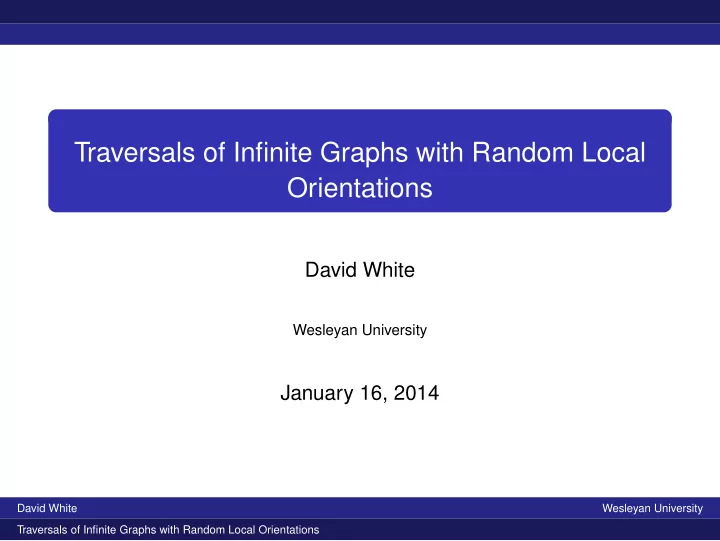

Traversals of Infinite Graphs with Random Local Orientations David White Wesleyan University January 16, 2014 David White Wesleyan University Traversals of Infinite Graphs with Random Local Orientations
Graph Exploration by a Mobile Entity Big Problem: graph exploration by a mobile entity using only constant memory, e.g. software moving on a network, web-crawler on the internet, a robot exploring an unfamiliar terrain. Let’s focus on a simple case: G = [ n ] × [ n ] or Z × Z . From any vertex, how does agent choose where to go next? One method: simple random walk. Cover time is O ( | V | 2 ) . Duplicating work. David White Wesleyan University Traversals of Infinite Graphs with Random Local Orientations
Basic Walk The basic walk is an alternative to the simple random walk proposed by Leszek G ˛ asieniec. Make all edges in G bidirectional and label both directions. At every v , the outgoing labels are 1 , 2 , . . . , deg ( v ) Give the agent 2 bits of memory. If it enters a vertex v along edge labeled i then it exits by label i + 1 mod deg ( v ) . There is a labeling with cover time O ( | V | ) . The random basic walk labels all edges uniformly at random at the start, then chooses a random starting point. David White Wesleyan University Traversals of Infinite Graphs with Random Local Orientations
Example: Basic Walk David White Wesleyan University Traversals of Infinite Graphs with Random Local Orientations
Pólya’s Theorem for Simple Random Walk The simple random walk on G is recurrent if it returns to its starting vertex with probability 1. Otherwise it is transient . Transient walks escape to infinite distance from the starting vertex. Theorem (Pólya’s Theorem) The simple random walk on Z d is recurrent for d ≤ 2 , but transient for all d > 2 . Conjecture: The random basic walk will behave similarly. David White Wesleyan University Traversals of Infinite Graphs with Random Local Orientations
� � � � � � Transience vs. Cycling for Random Basic Walk The random basic walk need not return to its starting vertex at all. It could instead get trapped in a cycle: i + 1 i 1 � v � • � • v • i + 2 i + 3 4 2 i • • • 3 If this occurs with probability 1 we say the random basic walk cycles (note: it only explores a finite subgraph). Otherwise the random basic walk is transient (it escapes to infinity). Theorem (W.) In Z 2 , the random basic walk cycles with probability 1 . David White Wesleyan University Traversals of Infinite Graphs with Random Local Orientations
Proof of cycling: Shells Method Theorem (W.) In Z 2 , the random basic walk cycles with probability 1 . Corollary (Random Basic Walk behaves very differently from SRW) The random basic walk cycles on any Z d , due to hypercube shells. David White Wesleyan University Traversals of Infinite Graphs with Random Local Orientations
Generalizations The shells method works for expander graphs, but more is true: Theorem (W.) On any graph G with all vertex degrees bounded by a constant D, the random basic walk cycles with probability 1. Theorem (W.) Let T be the tree where every vertex in level n has 2 n children. Then the random basic walk on T is transient. David White Wesleyan University Traversals of Infinite Graphs with Random Local Orientations
Results on Finite Graphs Our proof methods provide upper bounds on the expected number of vertices a random basic walk will visit on finite grids. The class of complete graphs has random basic walks asymptotically visit a constant fraction of the nodes: Theorem (joint with Danny Krizanc) As n → ∞ , a random basic walk on K n is expected to visit at least ( 1 − 1 / e ) ∗ n nodes. Conjecture The expected number of arcs traversed by a random basic walk on K n is 1 . 8 ∗ n as n → ∞ . Details are in my thesis, at arXiv:1308.1041 David White Wesleyan University Traversals of Infinite Graphs with Random Local Orientations
Recommend
More recommend